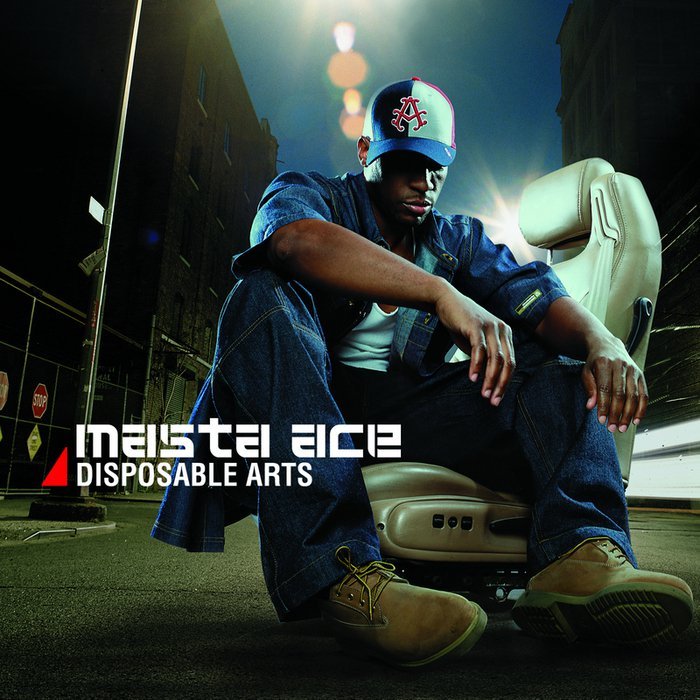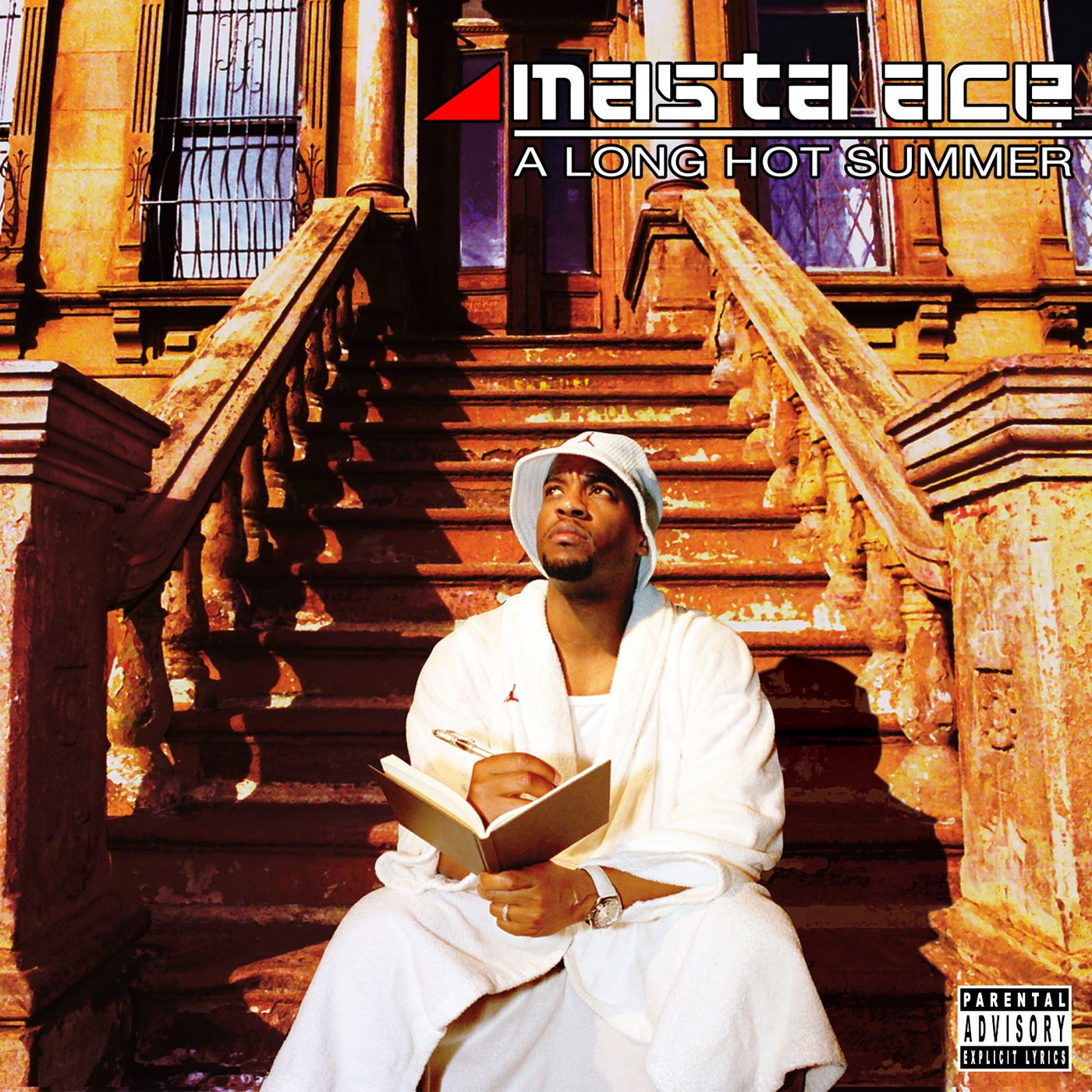Happy 35th Anniversary to Masta Ace’s debut album Take A Look Around, originally released July 24, 1990.
[Editor’s Note: Take A Look Around is not currently available in authorized form via major streaming platforms, hence the absence of audio/video embedded in the article below.]
Few artists have the poetical soul and the observational eyes of Duval “Masta Ace” Clear. He’s one of hip-hop’s foremost anthropologists, studying history and culture and transforming all of it into language that reflects the beauty and tragedy of life. In 2025, he remains one of the genre’s most respected orators, maintaining a level of consistency that few rappers have achieved. But if you listened to Take A Look Around, his debut album, released 35 years ago, you could tell that his talent would lead him to great places.
Ace has recorded “concept” albums throughout his career, weaving lengthy narratives with lots of connective tissue. This has especially been the case across the last 25 years or so of his career, but even his pair of albums that he released in the mid-’90s—SlaughtaHouse (1993) and Sittin’ On Chrome (1995)—are built on complex account of life.
Truthfully, Take A Look Around qualifies as a concept album as well. It’s a dedication to Brownsville, Brooklyn, the neighborhood of Masta Ace’s youth. Ace transports the listeners to what was then one of the most rugged areas of New York City, reflecting on both the good and bad that helped define his life, and contemplating how areas like it shape the Black experience in the United States.
According to Ben Merlis’ Goin’ Off: The Story of the Juice Crew & Cold Chillin’ Records, Masta Ace first connected with Marley Marl after winning a rap contest/battle in Queens, where first prize was six hours of studio time with the then-burgeoning production giant. Though it took six months for Ace to receive that six hours in Marley’s studio, Marley quickly recognized Ace’s talent and worked to involve him in his growing roster of talent. Masta Ace was soon featured prominently on Marley Marl’s In Control, Volume 1(1988) compilation.
Masta Ace is the only artist to appear on In Control three times. He has a memorable lead-off verse on “The Symphony,” considered by many to be the greatest posse cut of all time; the verse, featuring dazzling mic control and word play, put him on the map. He also had two solo cuts on the album: “Eyes on the Prize,” a dedication to living right, and “Simon Says,” a buoyant club-oriented track. The versatility Ace showed on In Control was a harbinger of things to come, especially on Take A Look Around. On his first album, he delivers more impressive verbal performances, waxes philosophical about living as a young Black man, and occasionally cuts loose for a little fun.
After hitting hard with his verse on “The Symphony,” Ace followed up his effort with a 12-inch release on Prizm, “Together” b/w “Letter To Better,” which he released under the name Ace and Action. Again, the single demonstrated Ace’s ability to shift gears and be convincing as both a wordsmith and a narrator of tales of survival. Ace capitalized on the momentum that he was building and recorded Take A Look Around.
Hip-hop production credits during the late 80s and early 90s were a mess, especially on Cold Chillin’ Records. For what it’s worth, Marley Marl and Mister Cee (Big Daddy Kane’s DJ and an accomplished producer in his own right) are listed as the main producers for Take A Look Around. Ace is given co-producer credit on every song on the album, something that many artists of the label coveted and asserted that they deserved during these early days, but only Ace received. According to Brian Coleman in Check the Technique 2, Ace said that every record that was sampled on that album came from his mother’s collection. Ace credits Marley for taking the samples and working his magic to make each “sound extra.”
I don’t know if Masta Ace’s mom had Grand Funk Railroad’s “Nothing Is the Same,” but Marley was able to turn the song’s bassline and guitar into an eminently catchy jam. The lead-off track “Music Man” serves as Ace’s statement of purpose for Take A Look Around, where he speaks for an underserved population and hopefully motivate those who come after him. “I'm here to reach the youth,” he raps. “The only way that I can do that is to teach the truth, so I do / Some used to diss and dismiss this / But then many of those small minds grew.”
Enjoying this article? Click/tap on the album covers to explore more about Masta Ace:
“Me & The Biz,” the first single used to promote the album, is a highly entertaining endeavor. The story goes that Ace was supposed to record the song with fellow Cold Chillin’ artist Biz Markie, but he didn’t make it to the stereo. So, instead of cancelling the studio time, Ace does his best gravelly-voiced impression of the Biz. The song’s legend increased after the release of the video, which features Ace performing with a puppet of the absent rapper.
Ace told Coleman that he thought it was a mistake to make the song the album’s first single, but I personally enjoy the song. The beat, built around a sample of Cymande’s “Bra,” is quite catchy. Meanwhile, Ace nails all of The Biz’s vocal mannerisms, tone, and presence, right down to his ad-libs.
On “Four Minus Three,” Ace takes it back to “The Symphony,” rhyming over the same piano-driven backdrop, but this time carrying the load on his own. The song exhibits Ace’s lyrical ability and breath control, as he delivers one long, masterful verse, with barely a pause. “Can’t Stop the Bumrush” features Ace doing lyrical windsprints over four whopping verses, combining his lines in innovative ways as he blesses a sample of the bassline from Little Royal and the Swingmaster’s “Razor Blade.”
Much of the real estate on Take A Look Around is built upon the ideas of gaining awareness of the problems that face the Black community and learning how to live in a way that improves the lives of all. On “I Got Ta,” Ace speaks on dealing with both the minutiae of life and his quest to become a better person. Nearly every line of the song begins with snippets of James Brown’s declaring “I got ta!” from “Talking Loud and Saying Nothing,” with Ace adding a kernel of wisdom. Ace declares how he’ll “Rip emcees like a paper bag,” “teach the youth that they’re capable,” and “show the ghetto is escapable.”
But Take A Look Around is mostly defined by the way Ace insightfully depicts life in Brooklyn in the ’80s and early ’90s, particularly in the gritty urban areas and neighborhoods where he grew up. He is elegiac in the ways he gives voices to the voiceless.
Ace takes the perspective of a homeless man on “Other Side of Town,” living destitute and urgently seeking a way to secure his next meal or place to sleep. His lyrics drip with bitterness and despair, as he’s both angry and resigned to living on the margins, without hope. “The life of a poor man, consider me desperate,” he raps. “I sleep in a cold room and wish I could just get / A piece of the pie is that asking too much? / I can’t even reach what others have in their clutch.”
“Movin’ On” illustrates the pointless, often banal cycle of violence, as in three different verses, he and his crew mercilessly assault three different victims for little or no reason at all. “Brooklyn Battles” is a depiction of Ace’s native Brooklyn neighborhood in its grim glory, underscoring that it’s not a place to take lightly. “You better know where you are first,” he raps. “Try to be rude and get chewed like a Starburst.” The song’s ending is especially potent, as Ace observes a five-on-one beat-down in progress, marveling at its brutally while expressing admiration for the recipient who’s “too proud to run.”
On “As I Reminisce,” Ace collaborates with his longtime friends, the crew Eyce U Rock (made up of brothers Eyce and Uneek, along with RokkDiesel) to describe life growing up in Brooklyn in a largely light-hearted manner. Sure, there’s the occasional reference to packing a razor blade or dealing with the fear getting your chain snatched, but mostly the rappers wistfully remember the days of playing Hot Peas and Butter, rocking Lee’s or sheepskins, and playing the dozens on the schoolyard. The beat, which heavily samples Monk Higgins & the Specialties version of “One Man Band (Play All Alone),” was apparently produced by Uneek. According to Ace, Mister Cee and Ace received production credit because Marley didn’t want a “no-name” to receive the production credit.
“Postin’ High” is another cheery yet thoughtful entry, chronicling Ace’s misadventure in a club with his crew, as he attempts to pull the hottest girl in the venue, only to have her pass him by in favor of Sterling-driving Merlin. Though much of the song is played for humor, it’s ostensibly about those without the aspirational means to find a way to live the good life. In the end, Ace concludes to try to post high but “keep a level mind,” “never put the next man down,” and “put your feet on the ground.”
Take A Look Around’s title track serves as the album’s heart. It’s a spoken-word piece, where Ace depicts the often-tragic lives of the residents of his neighborhood. He zeroes in on the neighborhood’s various lost souls, from the guy on the corner who plays the saxophone to the fly-girl turned crackhead to the homeless war veteran, encapsulating their lives in four bars apiece. In between he disperses knowledge, chastising those who sell their souls for material gain, imploring them to find a balance between pursuing money and pursuing happiness.
Even with the vivid portrayals of urban blight throughout Take A Look Around, the album ends on a positive note with “Together.” As mentioned earlier, the song was Ace’s first single, but it’s a fitting ending to the journey. To some degree, the track centers around Ace’s own drive to succeed. However, he preaches using his own success to help others in need. Ace seeks to empower and inspire, eschewing negativity and envisioning a more positive future.
Take A Look Around would be Ace’s first and only album with Cold Chillin’. Even though the album was a reasonable success, due to a decree from parent company Warner Bros., he was dropped by the label for not selling quite enough units; there was apparently a threshold and he was just around it. This was frustrating for Ace, unleashing an anger that’s palpable on the aforementioned SlaughtaHouse, his sophomore album.
Ace took what he learned during the recording of Take A Look Around and continued to apply it to his music career. Three-and-a-half decades later and he’s still going strong; A Breukelen Story and Richmond Hill, both recorded with producer Marco Polo, were among the best albums of 2018 and 2024, respectively, and two of the stronger entries in his discography. Take A Look Around was an amazing beginning to a great career, and still resonates in its observational power.
Editor's note: this anniversary tribute was originally published in 2020 and has since been edited for accuracy and timeliness.





